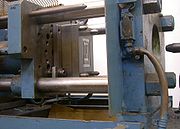
Injection molding machine
Encyclopedia

Plastic
A plastic material is any of a wide range of synthetic or semi-synthetic organic solids used in the manufacture of industrial products. Plastics are typically polymers of high molecular mass, and may contain other substances to improve performance and/or reduce production costs...
products by the injection molding
Injection molding
Injection molding is a manufacturing process for producing parts from both thermoplastic and thermosetting plastic materials. Material is fed into a heated barrel, mixed, and forced into a mold cavity where it cools and hardens to the configuration of the cavity...
process. It consists of two main parts, an injection unit and a clamping unit.
Injection molding machines can fasten the molds in either a horizontal or vertical position. The majority of machines are horizontally oriented, but vertical machines are used in some niche applications such as insert molding, allowing the machine to take advantage of gravity. There are many ways to fasten the tools to the platens, the most common being manual clamps (both halves are bolted to the platens); however hydraulic clamps (chocks are used to hold the tool in place) and magnetic clamps are also used. The magnetic and hydraulic clamps are used where fast tool changes are required.
Types of injection molding machines
Machines are classified primarily by the type of driving systems they use: hydraulic,mechanical, electric, or hybrid. Hydraulic presses have historically been the only option available to molders until Nissei Plastic Industrial Co., LTD introduced the first all-electric injection molding machine in 1983. The electric press, also known as Electric Machine Technology (EMT), reduces operation costs by cutting energy consumption and also addresses some of the environmental concerns surrounding the hydraulic press. Electric presses have been shown to be quieter, faster, and have a higher accuracy, however the machines are more expensive. Mechanical type machines use the toggle system for building up tonnage on the clamp side of the machine. Tonnage is required on all machines so that the clamp side of the machine does not open (i.e. tool half mounted on the platen) due to the injection pressure. If the tool half opens up it will create flash in the plastic product. Reliability of mechanical type of machines is more as tonnage built during each cycle is the same as compared to hydraulic machines. Hybrid injection molding machines claim to take advantage of the best features of both hydraulic and electric systems, but in actuality use almost the same amount of electricity to operate as a standard hydraulic. Hydraulic machines, although not nearly as precise, are the predominant type in most of the world, with the exception of Japan.A robotic arm
Robotic arm
A mechanical arm is a robotic, usually programmable, with similar functions to a human arm. The links of such a manipulator are connected by joints allowing either rotational motion or translational displacement. The links of the manipulator can be considered to form a kinematic chain...
is often used to remove the molded components; either by side or top entry, but it is more common for parts to drop out of the mold, through a chute and into a container.

